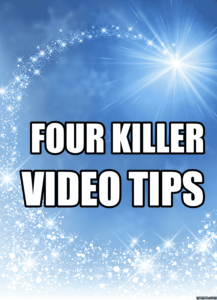25 Jan 4 Killer Video Tips For Fitness Pros
Guest Post By Daniel Freedman
Many fitness professionals know they have to get into the content game, but find writing isn’t really their thing. They should consider making videos instead.
I spent 20 years honing my craft as a television writer, producer, director, and news executive. Back in the day, you needed to spend a ton of money on equipment, camera people, and editing. No longer. Your iPhone is just about all you need to produce compelling video that builds your business. The videos may lack polish, but they can connect you with your audience in powerful ways.
Here’s how, beginning with…
What Should You Talk About?
Content that solves your clients’ problems is the lifeblood of your business.
But how do you determine the right content? One of the best ways is shockingly simple.
Just ask.
 If you’re training clients in person, ask them what they want from their workouts.
If you’re training clients in person, ask them what they want from their workouts.
Why do they want to lose fat? Is it to feel sexy and confident? Is it to have more energy to play with their kids? Do they want to improve their health so they can eventually walk their infant daughter down the aisle?
If you have an email list, simply send out:
“What is your biggest struggle with fitness? Is it working out, your nutrition, or something else? Reply to this message and we’ll chat further.”
Here are two other ways to generate video ideas.
1) What do you see in the gym that bothers you?
Highlight the mistakes people are making (diplomatically) and be the person who provides solutions.
2) What are the hot topics?
Is there an article or idea that’s trending? Share your thoughts. It’s that simple. When a topic is hot, it’s hot. Add your two-cents through your unique perspective.
How To Start Your Video
The way to start a video is to just start.
You don’t need a title graphic and theme music. You don’t need to introduce yourself. You don’t need the pointless “action montage” of you looking studly by throwing around heavy shit.
You just need to respect your viewers’ time and get started right away.
In many 2:30 videos I see, the first thirty seconds could — and should — have been omitted.
Maintain Your Focus
Your fourth grade teacher was right. You need to limit your topic. If the video is about easy-to-prepare recipes, don’t digress into a discussion of Intermittent Fasting. That’s another topic for another day.
The rule is one topic per video.
Be Yourself
“To thine own self be true.” The last thing you want to do is come across as a smarmy salesman peddling a quick fix. Above all, convey sincerity, integrity, knowledge and professionalism. All else pales in comparison. Let your personality shine through, without going off the cliff into narcissism. But remember to smile. It helps a lot. But first you have to learn to relax in front of the camera. This comes with practice.
Try watching this video with the audio turned off. You see a happy, engaged guy.
Want wine or a dessert for Valentine's Day?Go for it.This fitness stuff should improve your life, not consume.
Posted by Bach Performance on Tuesday, February 14, 2017
Video Technique #1: Just Talk Into The Camera
This is the simplest and most common technique. The camera is in a fixed position. You start. You talk. Then you stop. There is no editing.
But don’t mistake “no editing” for “no preparation.” Avoid looking like you are struggling to remember a memorized script. It comes across as stilted. The audience can see the wheels turning.
But don’t go to the other extreme: being so unprepared that you ramble on and on, saying the first random thing vaguely related to the topic that pops into your head.
Make a list of bullet points you want to cover. Then put the list away. Don’t glance down at the list when recording.
Record the video and play it back. Re-record if necessary. But don’t do endless takes. Better to put the video up and move on to the next one.
Like anything else, video production is a skill that improves with practice.
But remember: You are there to solve clients’ problems, not talk about your latest triumphs in the gym or life.
And there is really no reason to record the video in a stopped car or in front of a mansion. Or on a beach.
Dark sunglasses and medallions may not be the best wardrobe ideas. And being drunk isn’t a great idea, either.
Video Technique #2: The Self-Narrated Video
Self-narration is another simple technique. Once again, the camera does not move and there is no editing.
You act as the on-camera narrator and demo boy — all at the same time.
A slight variation is for you to narrate and have someone else be the demo boy. But good demo boys (or girls) are so hard to find!
Here’s an example of a self-narrated push-up demo.
Technique #3: Basic Editing
The video is not filmed in real time and the camera may move. It may intersperse talking heads shots with demo shots. Music may be added.
See this example from Neil Austin.
Note that Neil comes across as authoritative and credible. A great deal of information is packed into two minutes.
Here’s how Neil does his videos, in his own words:
Paragraph 1 – quick hello and breezy intro to the topic
Paragraph 2 – identify what people (mistakenly) think about the topic
Paragraph 3 – explain why they think that and why they’re wrong
Paragraph 4 – identify what your audience SHOULD think about the topic and how it can help them
Paragraph 5 – summarize the problem and the solution to the topic
Paragraph 6 – quick outro and call to action
Neil writes: “To save time and avoid having to do a bunch of takes, I memorize one paragraph at a time and film as I go. I’ve found that filming fresh like this allows me to stay authoritative and engaging enough that it’s worth having a few jump cuts.”
Technique #4 – Complex Editing
This can involve planning each shot and edit in advance, multiple cameras, and sophisticated audio and video editing. A five-minute video could involve anywhere from five to 50 hours of work.
Here’s an example using a single camera.
Frequently Asked Questions
Do I need to buy a professional camera?
No. The world has changed. Your phone or computer is fine. Your marketing dollars are better spent elsewhere.
But…
How can I make sure I’m heard?
Avoid recording in a noisy gym with clanging weights in peak periods. Background music is an absolute no-no if you are talking. Viewers can live with bad video, but not bad audio. If you can’t be heard clearly, don’t post the video. A lapel microphone that plugs into your phone can help. But it can’t work miracles in a noisy gym. Better to record in an empty gym with no music.
What about background music?
If you use background music in a video and you are also talking at the same time…make sure the music does not include lyrics. It should be instrumental only. You can’t have your words compete with the words in the song. It’s simply too much for the brain to process. It’s fine to have music with lyrics — as long as you are not talking at the same time. And it’s fine for you (or someone else) to talk with background music that has no lyrics. But don’t make your words compete with the words in the song. You will lose. Finally, do not use copyright music. Either pay to license music, use your own compositions, or use music you can prove does not require licensing.
How long should videos be?
The same length as a piece of string — the correct length for the task at hand. Or, in the immortal words of Jon Goodman, a video should be “as short as possible and as long as it needs to be.” Most videos can run two to seven minutes. But it’s impossible to make hard and fast rules.
Do you have more questions about video or anything else? Eric Bach and I run a private Facebook group for Fit Pros who want to build online businesses. It’s called Hybrid Fit Biz. Recent topics include refunds, guarantees, and email marketing strategies. Join the group here.
About The Author
 Daniel Freedman is an award-winning television producer and director who went on to edit The CrossFit Journal and consult with Precision Nutrition and The Personal Trainer Development Center. He now works with Eric Bach on a mentorship program for fitness professionals who want to build online businesses.
Daniel Freedman is an award-winning television producer and director who went on to edit The CrossFit Journal and consult with Precision Nutrition and The Personal Trainer Development Center. He now works with Eric Bach on a mentorship program for fitness professionals who want to build online businesses.


